Comic Book Confidential: Jimmy Olsen – The Jack Kirby Years

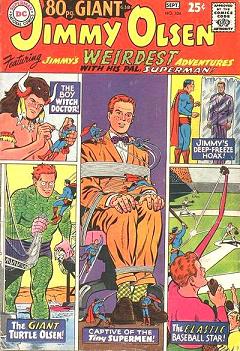
Some typical Jimmy Olsen adventure in the pre-Kirby days.
The world of comic books was extremely turbulent on both sides of the illustrated page as the 1970’s dawned. Marvel Comics had undergone a recent change of ownership, the biggest fallout from which was the departure of one of the founding members of the company, the legendary Jack “King” Kirby. Kirby made a short but lucrative jump to Marvel’s primary competitor DC Comics who were only too happy to have him return to the fold. During previous stints working for DC, Kirby had revamped and created a number of popular characters including the first true team of the Silver Age, the Challengers of the Unknown. Kirby, who had been feeling increasingly stifled creatively at Marvel, had some major plans for DC. He not only wanted to create new characters, but two entirely new planet’s worth of them. This concept, which would eventually be referred to as Jack Kirby’s Fourth World, spanned multiple books and introduced countless characters into the DC Universe. With so much inspiration and work that lay ahead of him, the most logical way for DC to launch this creative whirlwind was to put him charge of Jimmy Olsen!
The exact facts of the case have never been made public but it is generally accepted that part of Kirby’s contract with DC called for him to work on at least one existing title. There had been talk at the time of possibly turning all of the Superman titles over to Kirby since the Man of Steel was already slated for a major overhaul so starting the new hire on one of the companion books would certainly be a step in the right direction. Superman’s Pal Jimmy Olsen (the full and proper title of the book) was also without a creative team at the time due probably in no small part to the fact that it was one DC’s poorest selling comic books and the writing was already on the wall that it might not be around much longer. Kirby couldn’t have asked for much more of a challenge from an established title.
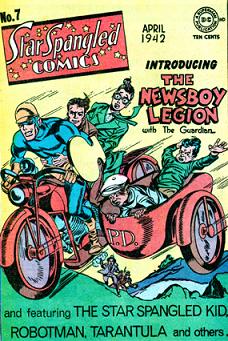
The original Newsboy Legion as they appeared in the 1940's.
Jimmy Olsen had been on newsstands for sixteen years when Jack Kirby and a couple of assistants took over the task of writing and illustrating the book. First appearing in 1941, Olsen was a youthful co-worker of Superman’s alter ego Clark Kent at the Daily Planet Newspaper who often found himself the center of some conflict that required the intervention of the book’s star, Superman, for resolution. In 1954, cashing in on the character’s popularity in the Adventures of Superman television series, Olsen was awarded his own title at DC Comics – four years earlier than Superman’s Girlfriend Lois Lane! The stories told in the Jimmy Olsen books were clearly aimed at a younger audience than the main Superman titles and usually featured the cub reporter/photographer being changed into some kind of monster, posing a bizarre threat to his pal, or uncovering an alien invasion or global threat. Whatever the theme of the issue, the structure followed the established path to the letter and Superman was always required in some fashion to solve the problem Jimmy couldn’t on his own.
Considering how flimsy, formulistic, and repetitive most of the plots were, it’s a wonder Jimmy Olsen had survived as long as it did and was still around for Jack Kirby to work on! His first order of business when he started with DC in 1970 was to begin revamping this title while also laying the groundwork for his Fourth World and establishing the New Gods, Mister Miracle, and Forever People books that would tell it’s epic saga. Kirby also had an ace up his sleeve (well more like five aces to be precise) in the form of the Newsboy Legion, a tough group of newspaper hawking orphans who lived by their wits in one the most dangerous sections of Metropolis – Suicide Slum.
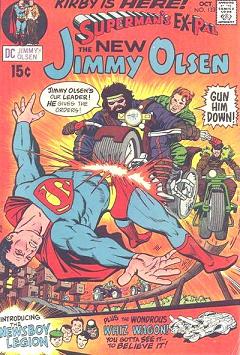
Jack Kirby's debut in issue #133.
The Newsboy Legion was almost as old as Jimmy Olsen himself, having been introduced one year later in 1942 in the pages of Star Spangled Comics. In those days it was not uncommon for a superhero to have a youthful sidekick or even, as in this case, a whole gang of youthful sidekicks. The Newsboys were created as supporting characters to Kirby’s new hero, The Guardian, who served as a poor man’s version of Captain America right down to the shield he carried as a weapon. By day, The Guardian was police officer Jim Harper, a by the book cop who decided to put on blue long johns and a gold crash helmet at night and handle the cases the police couldn’t with the help of his trusty shield. The Newsboy Legion, comprised of all American Tommy, intellectual Big Words, talkative Gabby, and the hot tempered Scrapper, were originally intended as comedy relief and dramatic ploys but they proved even more popular than the hero they were supposed to support and quickly began to command the majority of the story pages. Like many of their peers, The Guardian and the Newsboy Legion fell prey to the twilight of the Golden Age and disappeared into obscurity in 1947.
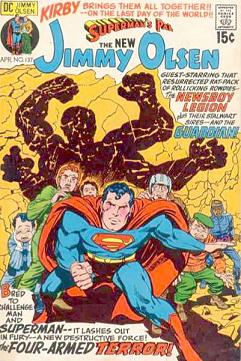
The Newsboy Legion finally made the cover of issue 137.
For their much heralded revival in the 70’s, Kirby realized their was no way he could tie in the original characters the way he wanted to no matter how badly comic books tended to mangle chronology (keep in mind that the Jimmy Olsen character would have been in his fifties in actual years at this point but his character had still just entered his twenties). Clearing this snag was no problem for the creative Kirby who revived his characters almost exactly as he left them except this new group of Newsboys was said to be the sons of the originals, who now just conveniently happened to all work at the DNA cloning facility Project Cadmus (referred to early on as just “The Project”) Kirby was about to introduce. The one major revision was the introduction of a new African-American character named Walter Johnson who had a mania for all things water related, especially scuba diving. Nicknamed Flipper or Flippa-Dippa, the self described “Ghetto Guppy” may have been designed to add some ethnic diversity to the Legion but the incongruent character was unmistakably a Jack Kirby creation.
Kirby’s run began with issue number 133 and he pulled out all the stops right from the beginning. This issue gave us the general setup for the run with Jimmy Olsen being introduced to his new reporting partners, the Newsboy Legion, and their newly manufactured all terrain flying armored car, the Whiz Wagon. While dodging murder attempts from their new boss Morgan Edge, secretly an operative for Kirby’s new organized crime operation Intergang, the boys discover Project Cadmus, the Newsboy Legion’s fathers, and a whole host of clones made from their DNA! To make sure no one missed the connection between this comic book and the other titles he was about to unveil on the public, Kirby also added the Evil Factory, a monstrous counterpart to Cadmus made from their stolen technologies and sanctioned by the dark ruler of the planet Apokolips (and chief villain of the Fourth World), Darkseid who made his comic book debut in issue 134.
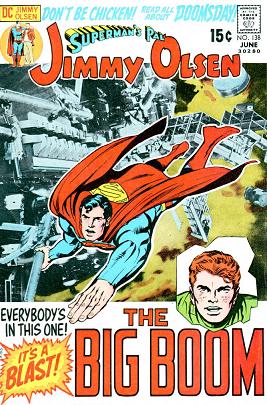
One of Jack Kirby's trademark collage covers for issue 138.
Not being one to waste an opportunity, Kirby also created a clone of The Guardian, now called The Golden Guardian, from the DNA and programmed memories of the original Jim Harper who was said to have been murdered in an Intergang assassination. With all of these heroes and villains added to what was once a very simplistic title, Kirby committed the cardinal sin of the book by not having enough of Superman in the pages and nearly crowding Jimmy Olsen out of his own title! Many of the stories would be divided up into concurrent plots with the Guardian and Superman tackling one problem, the Newsboy Legion following another, Jimmy Olsen and some accomplice handling something else and then everyone converging at the end. While some threads stretched through the entire run (some of which were never resolved) the main stories were limited to no more than two issues so it was difficult for Kirby to find adequate time for all the characters.
Sales for Superman’s Pal Jimmy Olsen soared as soon as Kirby took over and changed the look of the comic dramatically, maybe a little too much so for DC’s tastes. Many of the upper echelon had enjoyed the days of simpler stories and having Olsen turn into a giant turtle man that Superman had to catch and restore. Kirby’s Olsen was a serious young adult battling organized crime and often resenting Superman, in echoes of the topical generation gap, for saving him through what he only saw as interference. The Man of Steel was busy with his own problems as he discovered the world of Kirby’s New Gods which, for the first time, provided him with an entire race of people who were his equals. The book also touched lightly on many hot social issues like DNA manipulation and cloning that would have previously been considered outside its juvenile scope.
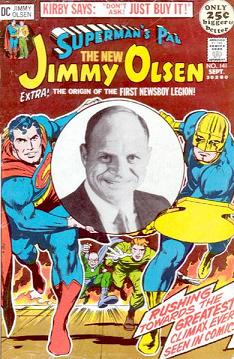
Issuue 141 - the conclusion of the infamous Don Rickles story!
Kirby managed to fill the pages of the book with vampires, mutants and even a thinly veiled Loch Ness Monster but nothing was as scary as Don Rickles! It was common practice in the 60’s and 70’s to have celebrity cameos in comic books to give them some type of tie in with the real world. Bob Hope and Jerry Lewis had each been honored with entire comic books built around their exaggerated antics so it wasn’t much of a stretch to work one of the most popular stand-up comedians of the day into a Jimmy Olsen story. The bizarre two issue arc featuring Rickles and his fabricated comic book twin Goody served its purpose but it didn’t mesh well with the remainder of the run and the concept was thankfully abandoned.
As issue number 147 was going to press, Kirby found out that he would shortly be relieved of his responsibilities concerning Jimmy Olsen and allowed to focus more on the new books he had created. One final issue was written to tie up some of the loose ends – a self contained story of Jimmy, the Newsboy Legion, and Superman thwarting a world domination plot by a non-Fourth World character named Victor Volcanum. This proved to be a refreshing combination of both the old and new Olsen styles and was as fitting a send off story as any transition in comic books was likely to receive at the time. Following that issue, Jimmy Olsen returned to being a slightly more mature version of his earlier self and both the Newsboy Legion and The Golden Guardian were largely forgotten again for many years.
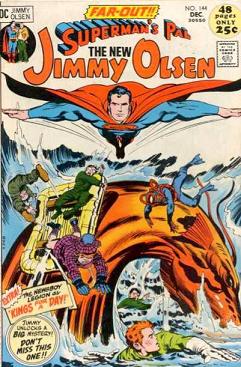
My personal favorite issue of the Kirby run featuring the Loch Trevor monster!
After the events of the Crisis on Infinite Earths in the mid 80’s, The Guardian (the Golden designation was dropped) and his sidekicks were revived and remain active to this day on an irregular basis. In a move that most elementary school children who read the title in the 70’s could have predicted, the modern Newsboy Legion was reveled to be clones of their fathers with their youthful memories implanted in much the same way Cadmus had replaced The Guardian. This explained their uncanny resemblance both personality and appearance wise to their fathers and the conspicuous absence of their mothers and any siblings. The most notable of these modern appearances was a four issue mini-series in 1994 that brought the characters and concepts Kirby had created twenty plus years earlier up to date and attempted to introduce some new ones like Jim Harper’s grand-niece, Famous Bobby. The mini-series lacked much of the Kirby flavor that had endeared the characters years earlier and was not picked up for an ongoing series.
After largely reverting back to the concepts that had almost caused it’s cancellation a few years earlier, Superman’s Pal Jimmy Olsen limped along for a few more years until it was assimilated, along with other Superman related books and back up stories, into a new deluxe title called Superman Family. It was an easy way to prop up several weak themes with just enough momentum to keep one entire book in business. Kirby continued to produce his Fourth World titles and introduced some new ones including OMAC, Kamandi, The Demon, and a new character with and an old name, The Sandman. While a few of these comics enjoyed healthy runs and all of them made a lasting mark on the DC Universe, Kirby ultimately decided he was happier at Marvel and returned there in 1975. Fans of his work though, many of whom never read the title before or after his run, still fondly recall the unique characters, strange styles, and entertaining stories he provided for a brief but shining period in the pages of Jimmy Olsen.
